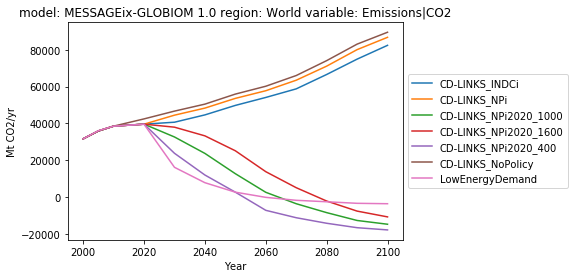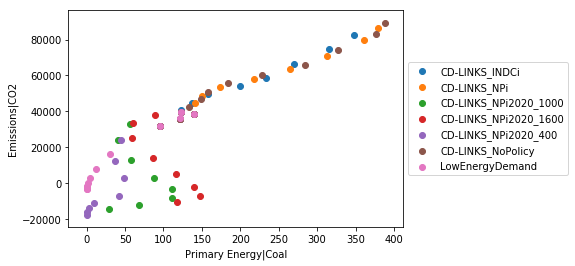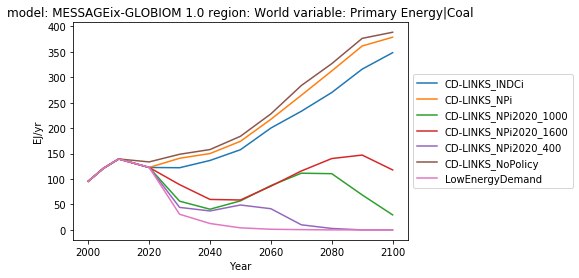Read Directly from IIASA Data Resources¶
IIASA’s new scenario
explorer
is not only a great resource on its own, but it also allows the
underlying datasets to be directly queried. pyam takes advantage of
this ability to allow you to easily pull data and work with it.
In [1]:
import pyam
from pyam.iiasa import valid_connection_names
There are currently not many available data sources, but more will be added with time
In [2]:
valid_connection_names()
Out[2]:
['iamc15']
In this example, we will be pulling data from the Special Report on 1.5C explorer. This can be done in a number of ways, for example
pyam.read_iiasa('iamc15')
pyam.read_iiasa_iamc15()
However, this would pull all available data. It is also possible to
query specific subsets of data in a manner similar to
pyam.IamDataFrame.filter(). We’ll do that to keep it manageable.
In [3]:
df = pyam.read_iiasa_iamc15(
model='MESSAGEix*',
variable=['Emissions|CO2', 'Primary Energy|Coal'],
region='World'
)
INFO:root:You are connected to the iamc15 scenario explorer. Please cite as:
D. Huppmann, E. Kriegler, V. Krey, K. Riahi, J. Rogelj, S.K. Rose, J. Weyant, et al., IAMC 1.5°C Scenario Explorer and Data hosted by IIASA. IIASA & IAMC, 2018. doi: 10.22022/SR15/08-2018.15429, url: data.ene.iiasa.ac.at/iamc-1.5c-explorer
Here we pulled out all results for model(s) that start with ‘MESSAGEix’ that are in the ‘World’ region and associated with the two named variables.
Let’s plot CO2 emissions.
In [4]:
ax = df.filter(variable='Emissions|CO2').line_plot(
color='scenario',
legend=dict(loc='center left', bbox_to_anchor=(1.0, 0.5))
)

And now continue doing all of your analysis!
In [5]:
ax = df.scatter(
x='Primary Energy|Coal',
y='Emissions|CO2',
color='scenario',
legend=dict(loc='center left', bbox_to_anchor=(1.0, 0.5))
)

Exploring the Data Source¶
If you’re interested in what data is actually in the data source, you
can use pyam.iiasa.Connection to do so.
In [6]:
conn = pyam.iiasa.Connection('iamc15')
INFO:root:You are connected to the iamc15 scenario explorer. Please cite as:
D. Huppmann, E. Kriegler, V. Krey, K. Riahi, J. Rogelj, S.K. Rose, J. Weyant, et al., IAMC 1.5°C Scenario Explorer and Data hosted by IIASA. IIASA & IAMC, 2018. doi: 10.22022/SR15/08-2018.15429, url: data.ene.iiasa.ac.at/iamc-1.5c-explorer
The conn object has a number of useful functions for listing what’s
in the dataset. A few of them are shown below.
In [7]:
conn.models().head()
Out[7]:
0 AIM/CGE 2.0
1 AIM/CGE 2.1
2 C-ROADS-5.005
3 GCAM 4.2
4 GENeSYS-MOD 1.0
Name: model, dtype: object
In [8]:
conn.scenarios().head()
Out[8]:
0 ADVANCE_2020_1.5C-2100
1 ADVANCE_2020_Med2C
2 ADVANCE_2020_WB2C
3 ADVANCE_2030_Med2C
4 ADVANCE_2030_Price1.5C
Name: scenario, dtype: object
In [9]:
conn.variables().head()
Out[9]:
0 AR5 climate diagnostics|Concentration|CO2|FAIR...
1 AR5 climate diagnostics|Concentration|CO2|MAGI...
2 AR5 climate diagnostics|Forcing|Aerosol|Direct...
3 AR5 climate diagnostics|Forcing|Aerosol|MAGICC...
4 AR5 climate diagnostics|Forcing|Aerosol|Total|...
Name: variable, dtype: object
In [10]:
conn.regions().head()
Out[10]:
0 World
1 R5ASIA
2 R5LAM
3 R5MAF
4 R5OECD90+EU
Name: region, dtype: object
You can directly query the the conn, which will give you a
pd.DataFrame
In [11]:
df = conn.query(
model='MESSAGEix*',
variable=['Emissions|CO2', 'Primary Energy|Coal'],
region='World'
)
df.head()
Out[11]:
| model | region | runId | scenario | time | unit | value | variable | version | year | |
|---|---|---|---|---|---|---|---|---|---|---|
| 0 | MESSAGEix-GLOBIOM 1.0 | World | 238 | CD-LINKS_INDCi | -1 | Mt CO2/yr | 31667.90819 | Emissions|CO2 | 1 | 2000 |
| 1 | MESSAGEix-GLOBIOM 1.0 | World | 238 | CD-LINKS_INDCi | -1 | Mt CO2/yr | 35933.06970 | Emissions|CO2 | 1 | 2005 |
| 2 | MESSAGEix-GLOBIOM 1.0 | World | 238 | CD-LINKS_INDCi | -1 | Mt CO2/yr | 38542.01816 | Emissions|CO2 | 1 | 2010 |
| 3 | MESSAGEix-GLOBIOM 1.0 | World | 238 | CD-LINKS_INDCi | -1 | Mt CO2/yr | 39615.22255 | Emissions|CO2 | 1 | 2020 |
| 4 | MESSAGEix-GLOBIOM 1.0 | World | 238 | CD-LINKS_INDCi | -1 | Mt CO2/yr | 40671.28065 | Emissions|CO2 | 1 | 2030 |
And you can easily turn this into a pyam.IamDataFrame to continue
your analysis.
In [12]:
df = pyam.IamDataFrame(df)
ax = df.filter(variable='Primary Energy|Coal').line_plot(
color='scenario',
legend=dict(loc='center left', bbox_to_anchor=(1.0, 0.5))
)
